Iowa Ham Balls
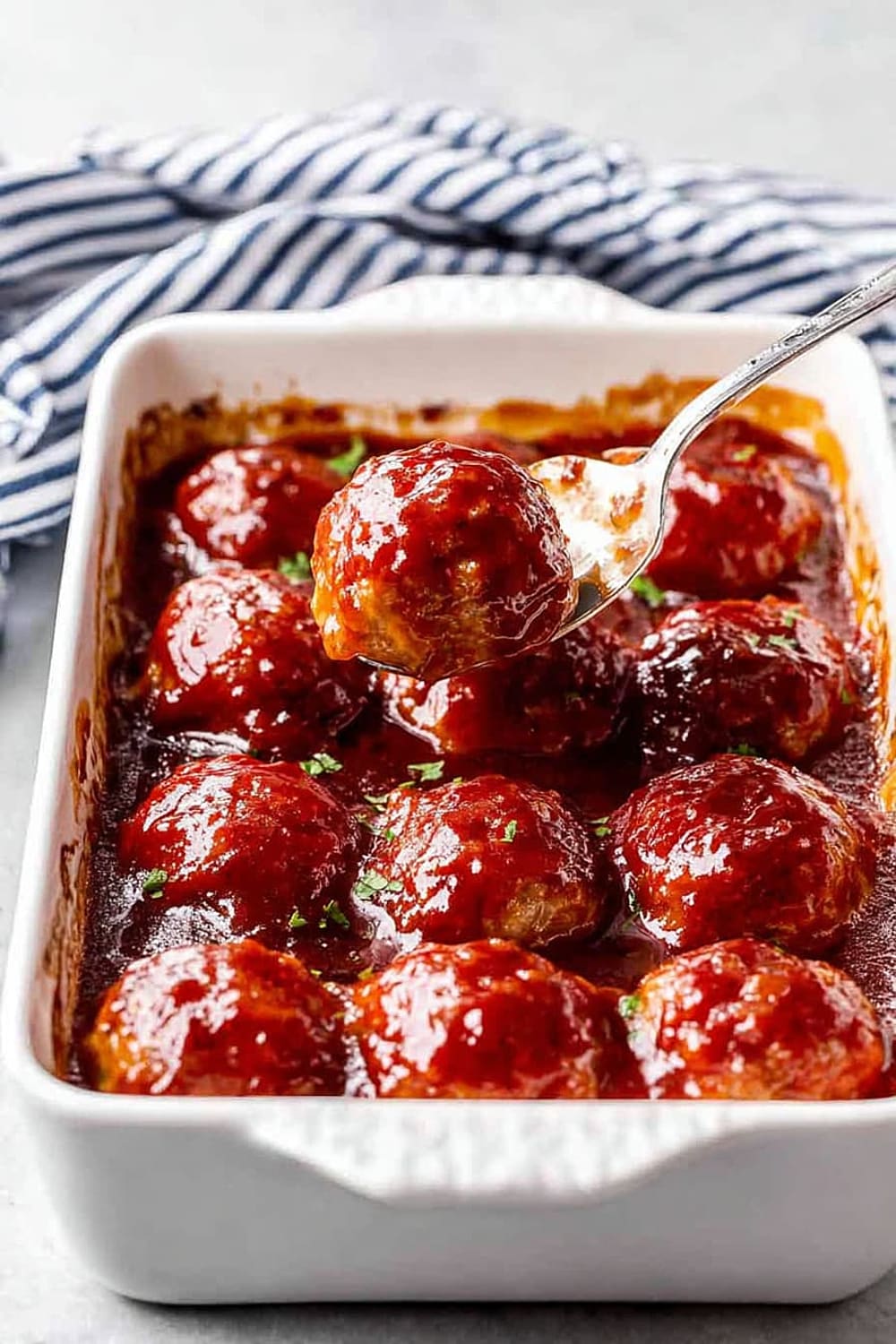
These Iowa Ham Balls are about to become your new favorite way to use up leftover ham, and trust me, you’ll be planning ham dinners just to have leftovers for this recipe.
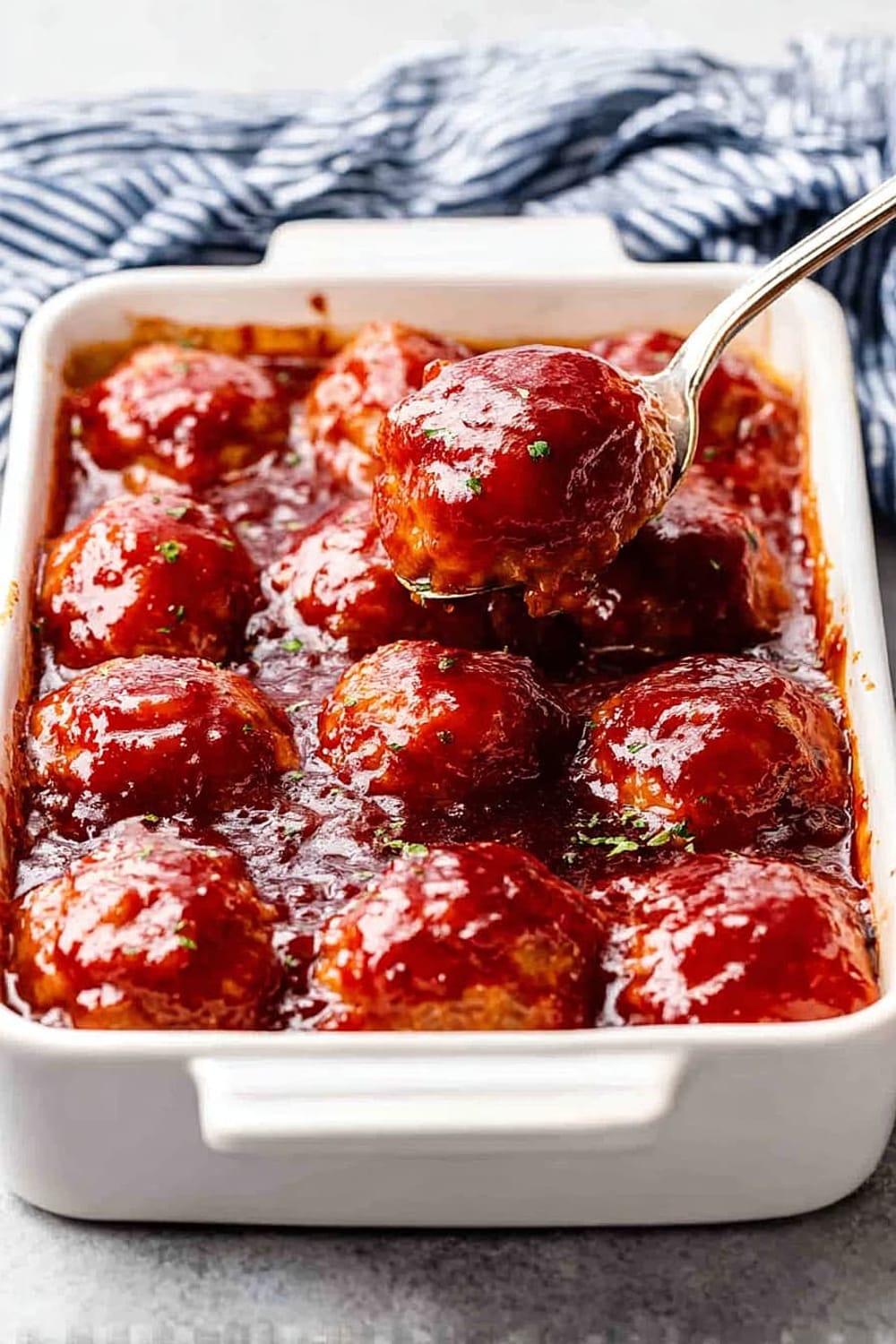
Picture this: tender, savory ham balls swimming in a glossy, sweet-tangy glaze that’s basically the perfect marriage of ketchup, brown sugar, and vinegar – it’s comfort food that knows how to dress up for company.
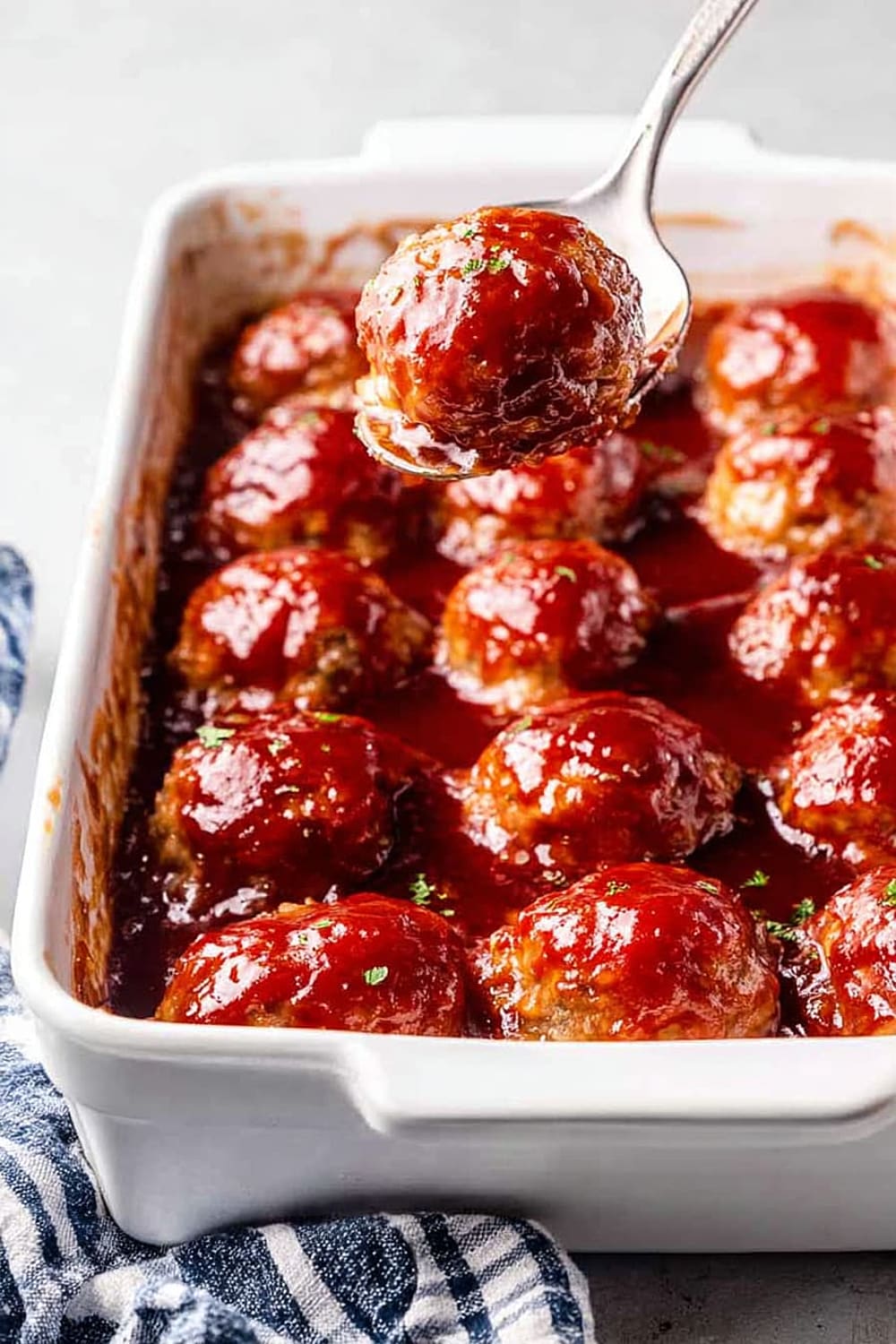
This Midwestern classic transforms humble ingredients into something that’ll have your dinner guests asking for the recipe before they’ve even finished their first bite.
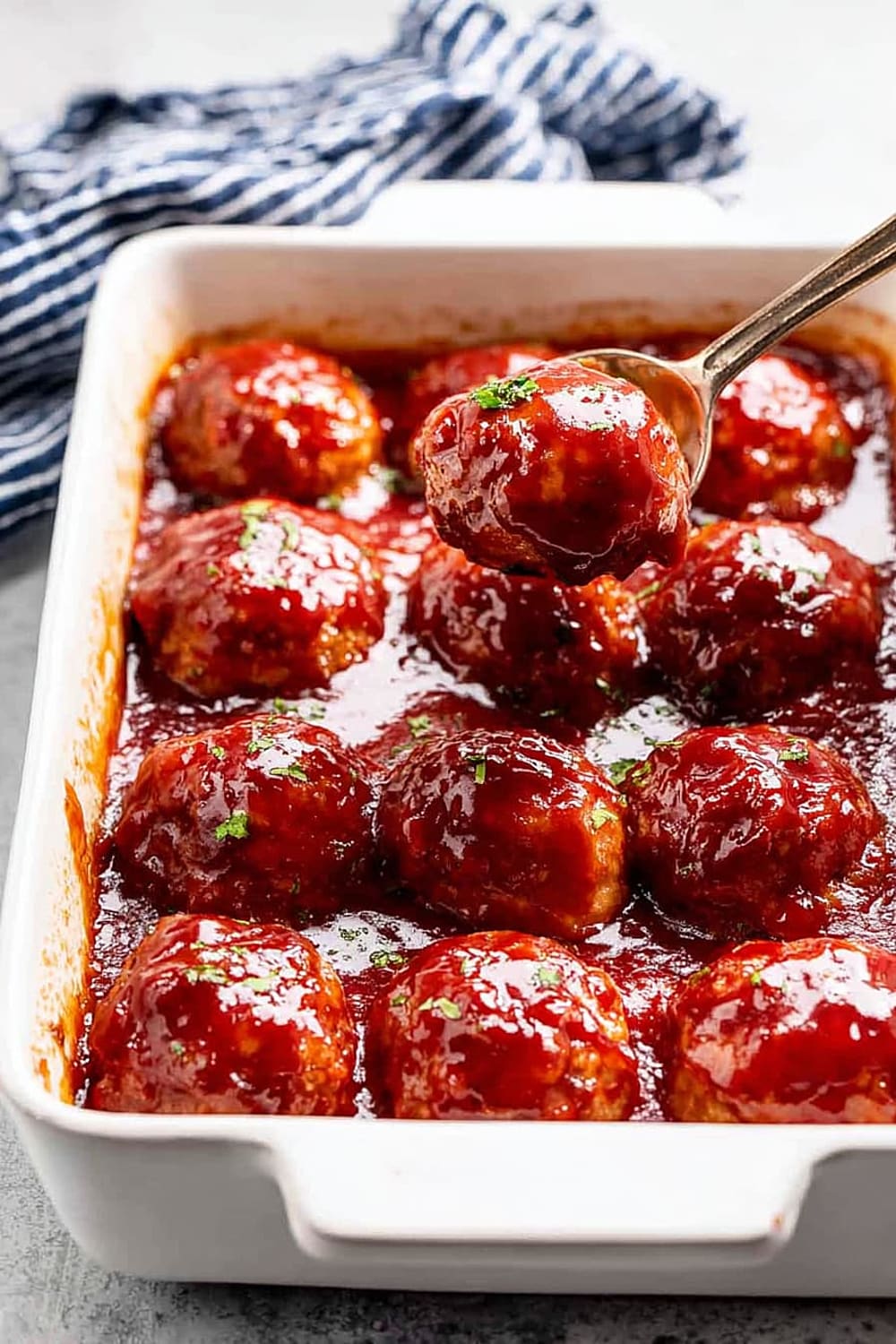
The secret weapon here is the graham cracker crumbs instead of regular breadcrumbs, which adds a subtle sweetness that plays beautifully with that sticky glaze.
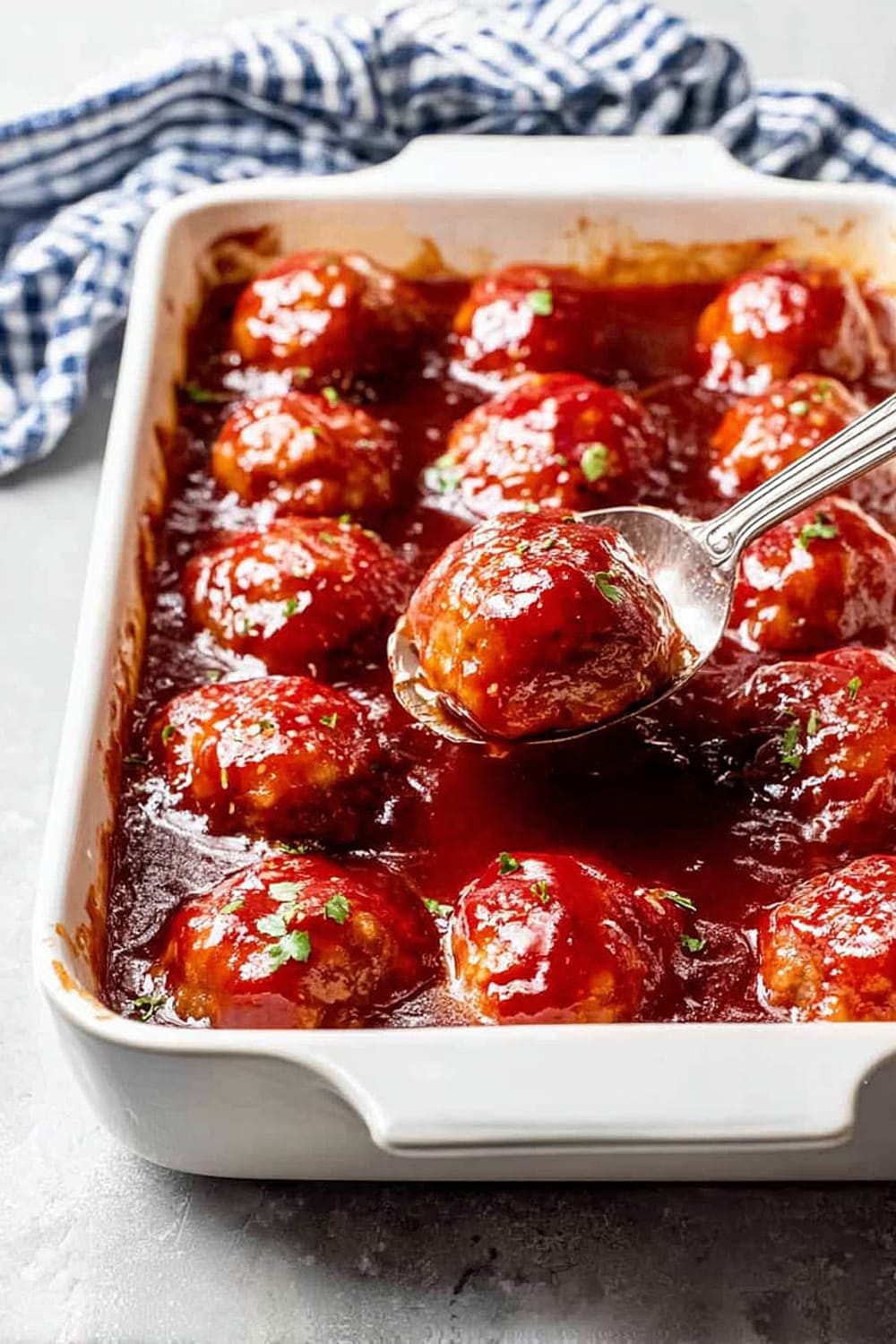
Whether you’re serving these as a hearty main dish with mashed potatoes or rolling them smaller for the ultimate party appetizer, they’re guaranteed crowd-pleasers that taste way more complicated than they actually are.

Plus, this is one of those magical recipes where leftovers (if there are any) taste even better the next day after all those flavors have had time to mingle and get acquainted.
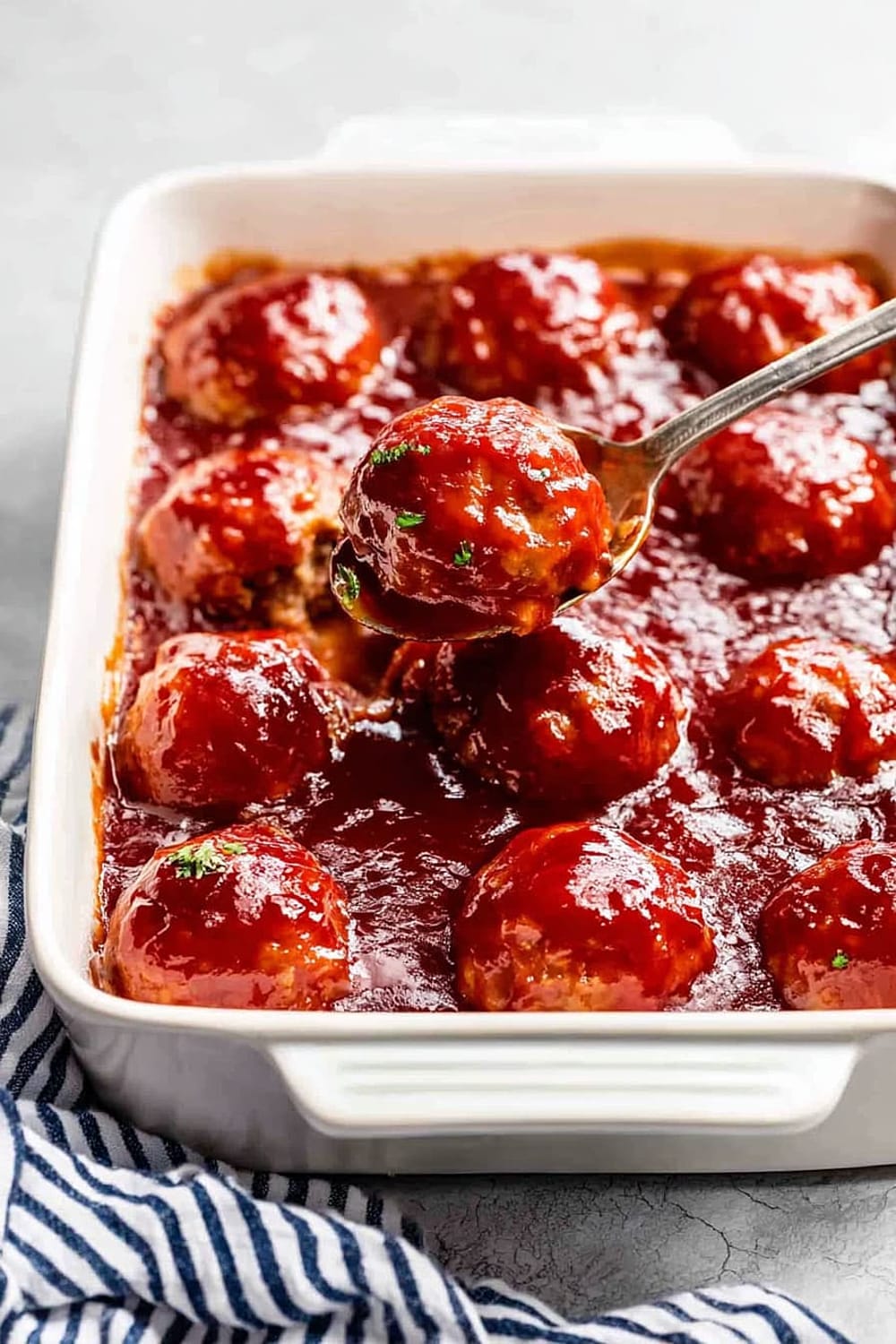
Ingredients
For the Ham Balls
- 2 pounds leftover ham, ground in a food processor or meat grinder
- 1 pound ground pork
- 2 large eggs, beaten
- 1¾ cups graham cracker crumbs
- 1 cup whole milk
- ¼ cup dehydrated minced onion
For the Glaze
- 1½ cups ketchup
- 1 cup brown sugar, packed
- ¼ cup cider vinegar
- 1 teaspoon dried mustard
Instructions
Preparation
- 1 Preheat your oven to 350°F (175°C) and lightly grease a 9×13-inch baking dish with cooking spray or butter. This size dish ensures the ham balls have enough room to cook evenly without overcrowding.
- 2 Using a food processor, pulse the leftover ham until it’s finely ground but still has some texture – you want small, uniform pieces rather than a smooth paste. If you don’t have a food processor, a meat grinder works perfectly, or you can ask your butcher to grind it for you.
- 3 In a large mixing bowl, combine the ground ham, ground pork, beaten eggs, graham cracker crumbs, whole milk, and dehydrated minced onion. The graham cracker crumbs act as both a binder and add a subtle sweetness that complements the glaze beautifully.
Mixing and Shaping
- 4 Using clean hands, gently mix all the ham ball ingredients together until just combined. Don’t overwork the mixture – this is the key to keeping your ham balls tender rather than dense and tough. The mixture should hold together when squeezed but still feel light.
- 5 Shape the mixture into balls using a large cookie scoop or ⅓ cup measuring cup for main dish portions, or use a smaller scoop for appetizer-sized portions. You should get approximately 10-12 large ham balls or 20-24 smaller ones. Roll each portion lightly between your palms to create smooth, round shapes.
- 6 Arrange the shaped ham balls in a single layer in your prepared baking dish, leaving about 1 inch of space between each ball to allow for even cooking and browning.
Initial Baking
- 7 Place the baking dish in the preheated oven and bake for 45 minutes. During this time, the ham balls will firm up and develop a light golden exterior while staying moist inside.
Preparing and Adding the Glaze
- 8 While the ham balls are baking, whisk together the glaze ingredients in a medium bowl. Combine the ketchup, brown sugar, cider vinegar, and dried mustard until the mixture is smooth and the brown sugar is completely dissolved. The glaze should be glossy and pourable.
- 9 After the ham balls have baked for 45 minutes, carefully remove the dish from the oven. Pour the prepared glaze evenly over all the ham balls, making sure each one gets coated. The glaze will pool around the bottom of the dish, which is exactly what you want.
Final Baking
- 10 Return the glazed ham balls to the oven and continue baking for an additional 15 minutes, until the glaze is hot, bubbling, and has developed a beautiful caramelized color. The internal temperature of the ham balls should reach 160°F (71°C) when tested with an instant-read thermometer.
- 11 Remove from oven and let rest for 5 minutes before serving. This allows the glaze to thicken slightly and makes serving easier. Serve with rice, mashed potatoes, and a green vegetable for dinner, or provide toothpicks for appetizer service.
Recommended Equipment and Kitchen Tools
Essential Tools (for best results)
- Food processor – Makes quick work of grinding the ham to the perfect texture without turning it into paste
- Large mixing bowls – Essential for combining ingredients without making a mess
- Cookie scoop or ice cream scoop – Ensures uniform ham ball sizes for even cooking
- 9×13-inch baking dish – The perfect size for proper spacing and even heat distribution
Helpful Upgrades
- Instant-read thermometer – Takes the guesswork out of doneness, ensuring food safety
- Silicone spatula – Perfect for scraping every bit of glaze from the mixing bowl
- Parchment paper – Line your baking dish for easier cleanup, though greasing works just fine
- Kitchen scale – For precise measurements, especially when scaling the recipe up or down
Nice-to-Have Options
Meat grinder – If you prefer more control over the ham texture than a food processor provides
Wire cooling rack – Useful if you want to drain excess fat before adding the glaze
Bench scraper – Helps with portioning the mixture evenly before shaping
These tools make the process smoother, but don’t let missing equipment stop you from making this recipe – clean hands and basic kitchen tools will get the job done beautifully.
Recipe Variations and Dietary Modifications
Meat Variations
- Turkey Ham Balls – Substitute ground turkey for the pork and use turkey ham for a leaner option
- Beef and Ham Combo – Replace ground pork with lean ground beef for a heartier flavor
- All-Ham Version – Use 3 pounds ground ham total and add an extra egg for binding
Glaze Alternatives
- Maple Glaze – Replace brown sugar with ¾ cup pure maple syrup and reduce vinegar to 2 tablespoons
- Honey Mustard Glaze – Add 2 tablespoons Dijon mustard and ¼ cup honey to the base recipe
- Pineapple Glaze – Include ½ cup crushed pineapple (drained) for a tropical twist
Binding Substitutions
- Panko Breadcrumbs – Replace graham crackers with 1½ cups panko for a more traditional texture
- Crushed Crackers – Use 1¾ cups crushed saltines or Ritz crackers for different flavor notes
- Oat Flour – Substitute 1 cup oat flour plus ½ cup rolled oats for added fiber
Size and Serving Variations
- Mini Appetizer Balls – Make 40-50 small balls using a 1-tablespoon scoop
- Slider Patties – Shape into 8-10 patties for ham ball sandwiches
- Casserole Style – Press mixture into baking dish, top with glaze, and slice into squares
Nutritional Information and Health Benefits
Key Nutritional Highlights
Each large ham ball provides approximately 280-320 calories, with a robust 18-22 grams of protein from the ham and pork combination. The recipe delivers substantial B-vitamins, particularly B12 and thiamine, essential for energy metabolism and nervous system function. While the glaze adds carbohydrates, each serving contains about 25-30 grams of carbs, making it moderate in the context of a complete meal.
Health Benefits of Main Ingredients
The ham and pork provide complete proteins containing all essential amino acids necessary for muscle maintenance and repair. Eggs contribute choline for brain health and selenium for immune function. The milk adds calcium and phosphorus for bone health, while also helping create the tender texture. Even the graham cracker crumbs provide some B-vitamins and iron, though they’re primarily for texture and binding.
Dietary Considerations
This recipe is naturally gluten-free if you substitute the graham crackers with gluten-free alternatives. It’s high in sodium due to the cured ham, so those monitoring salt intake should consider smaller portions. The dish provides good satiety due to its protein and fat content, making it filling enough to serve as a complete main course when paired with vegetables and a starch.
Smart Swaps and Ingredient Substitutions
Ham Alternatives:
- Leftover turkey → Use 2 pounds ground cooked turkey with 1 teaspoon smoked paprika for depth
- No leftover ham → Purchase 2 pounds deli ham and grind it yourself
- Canadian bacon → Substitute pound-for-pound, but reduce salt in other components
Binding Agent Swaps:
- Graham cracker crumbs → 1½ cups panko breadcrumbs plus 2 tablespoons brown sugar
- Out of graham crackers → 1¾ cups crushed vanilla wafers work beautifully
- Gluten-free option → 1¾ cups almond flour plus ¼ cup tapioca starch
Liquid Substitutions:
- Whole milk → ¾ cup heavy cream mixed with ¼ cup water for richness
- Dairy-free → 1 cup unsweetened oat milk or coconut milk from a carton
- Buttermilk → Creates tangier flavor and more tender texture
Glaze Modifications:
- Brown sugar → 1 cup coconut sugar or ¾ cup maple syrup (reduce liquid slightly)
- Ketchup → 1 cup tomato sauce plus 2 tablespoons apple cider vinegar and 1 tablespoon sugar
- Cider vinegar → White wine vinegar or rice vinegar for milder acidity
Pro Tips for Substitutions:
- Always maintain the same total liquid volume when swapping milk alternatives
- Taste-test your glaze before adding – some substitutions may need seasoning adjustments
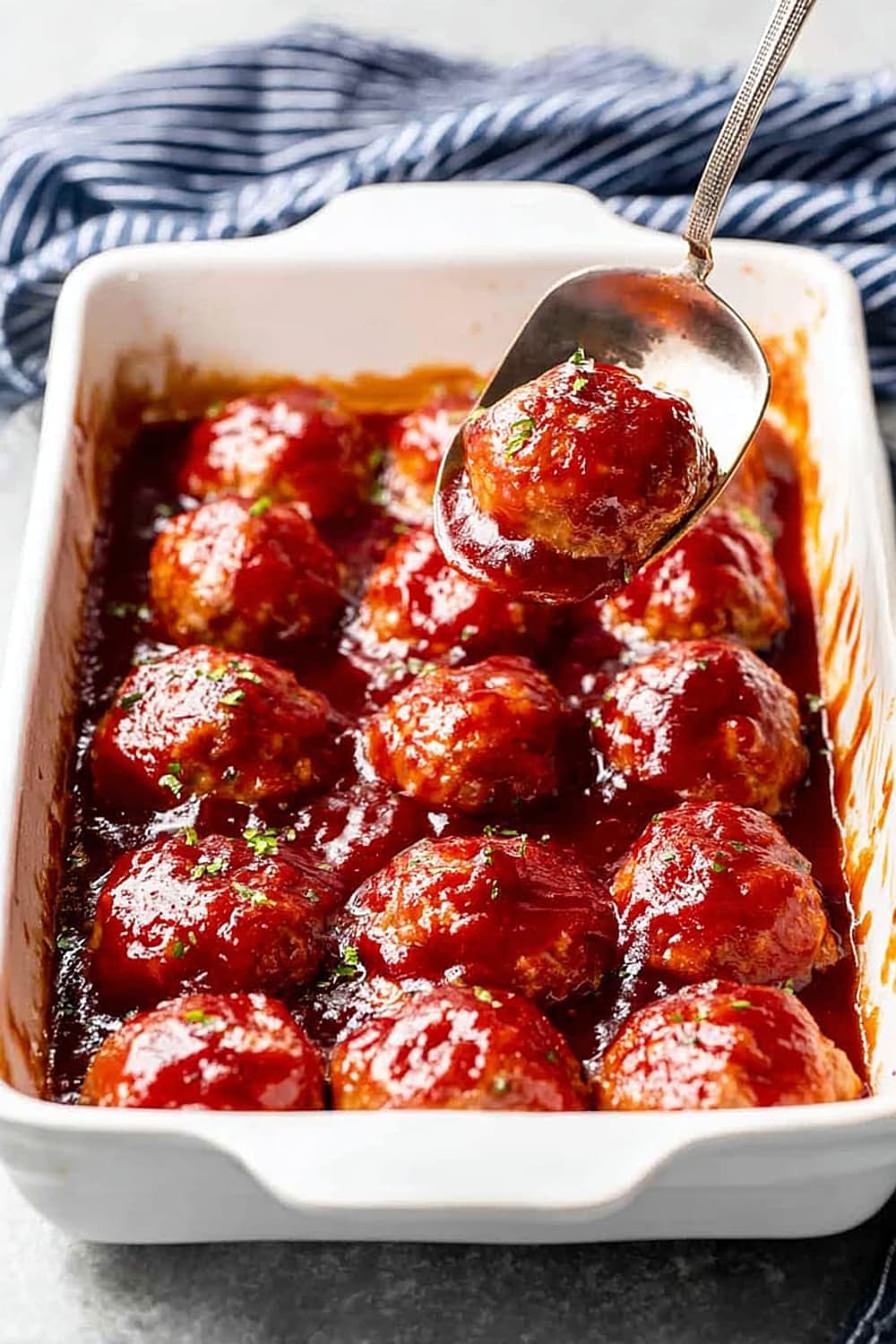
Make It Diabetes-Friendly
Sugar Reduction Strategies:
- Replace brown sugar with ½ cup sugar-free brown sugar substitute (like Lakanto or Swerve) to reduce carbs by approximately 15-20 grams per serving
- Ketchup swap → Use sugar-free ketchup or make your own with tomato paste, vinegar, and stevia
- Graham cracker alternative → 1½ cups almond flour plus 2 tablespoons psyllium husk reduces carbs significantly
Portion and Pairing Tips:
- Smaller serving sizes → Make 16-20 smaller balls instead of 10-12 large ones
- Estimated carbs per small ball → Approximately 8-10 grams with traditional recipe, 4-6 grams with modifications
- Smart pairings → Serve with cauliflower mash instead of potatoes, and plenty of non-starchy vegetables
Cooking Method Adjustments:
- Extra vegetables → Add 1 cup finely diced bell peppers and ½ cup celery to the mixture for fiber and volume
- Glaze reduction → Use only half the glaze and add 1 tablespoon tomato paste for thickness without extra sugar
Total Carb Reduction: These modifications can reduce carbs from 25-30 grams per serving to 12-15 grams per serving.
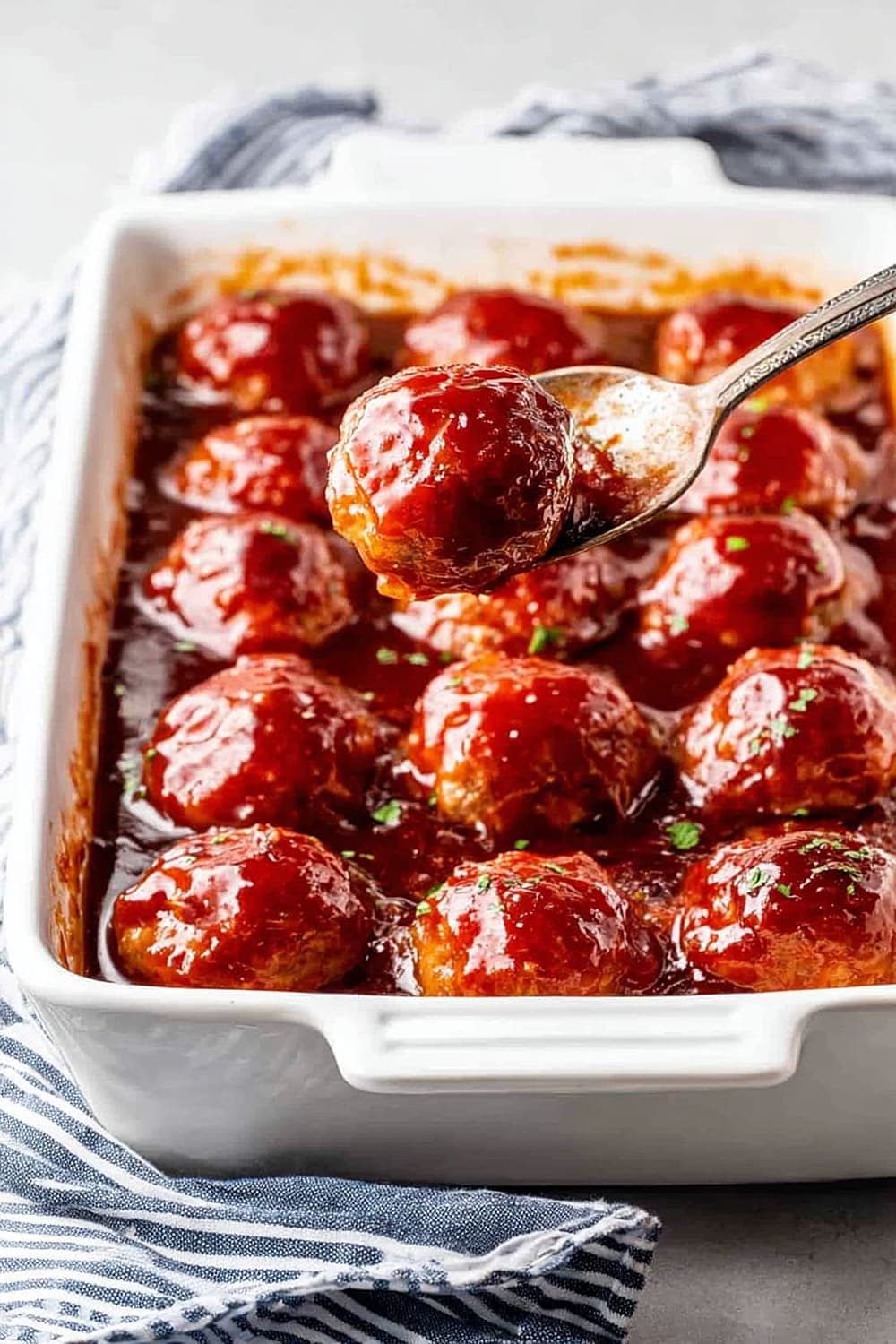
Perfect Pairing Suggestions
Beverage Pairings
The sweet-tangy glaze pairs beautifully with medium-bodied red wines like Merlot or Zinfandel, which complement the ham’s smokiness without overwhelming the dish. For beer lovers, a wheat beer or amber ale provides the perfect balance to cut through the richness. Non-alcoholic options include sparkling apple cider, sweet tea, or ginger beer for a refreshing contrast to the savory-sweet flavors.
Side Dish Recommendations
Creamy mashed potatoes are the classic pairing, soaking up that incredible glaze, while wild rice pilaf adds nutty complexity. Roasted Brussels sprouts with bacon provide a bitter contrast that balances the sweetness, and honey-glazed carrots complement the ham balls’ flavor profile. Fresh green beans or steamed broccoli add color and freshness to round out the plate.
Complete Meal Ideas
Start with a simple salad with vinaigrette to cleanse the palate before the rich main course. For entertaining, serve these as appetizers alongside cheese and crackers, deviled eggs, and vegetable crudité. Follow up with a light dessert like lemon sorbet or fresh fruit to cleanse the palate after such a satisfying, rich dish.
Occasion Suggestions
These ham balls shine at potluck dinners, holiday gatherings, and casual family dinners. They’re perfect for Easter or Christmas when you have leftover ham, and they make excellent game day appetizers when rolled smaller and served with toothpicks.
Pro Tips and Troubleshooting
Professional Techniques
Chill your shaped ham balls for 30 minutes before baking – this helps them hold their shape better and prevents spreading. When grinding ham in a food processor, work in batches and pulse rather than running continuously to avoid creating a paste-like texture. For the most tender results, let your eggs and milk come to room temperature before mixing, which helps everything combine more evenly.
Common Mistakes and Solutions
If your ham balls are falling apart, you likely over-ground the ham or under-mixed the binding ingredients. Add an extra egg if the mixture seems too loose. Dense, tough ham balls result from overmixing – treat the mixture like meatloaf and mix just until combined. If the glaze seems too thick, thin it with a tablespoon of water; if too thin, simmer it on the stovetop for a few minutes to reduce.
Storage and Reheating
Store leftover ham balls in the refrigerator for up to 4 days or freeze for up to 3 months. Reheat gently in a 300°F (150°C) oven covered with foil to prevent drying out. The glaze may separate when reheated – simply stir it back together or add a splash of water.
Make-Ahead Strategies
Shape the ham balls up to 24 hours ahead and refrigerate covered. You can also fully cook and glaze them, then reheat for serving. The flavors actually improve overnight as everything melds together.
This recipe proves that the best comfort foods often come from the most humble ingredients, transformed by a little technique and a lot of love into something truly special that’ll have everyone asking for seconds.